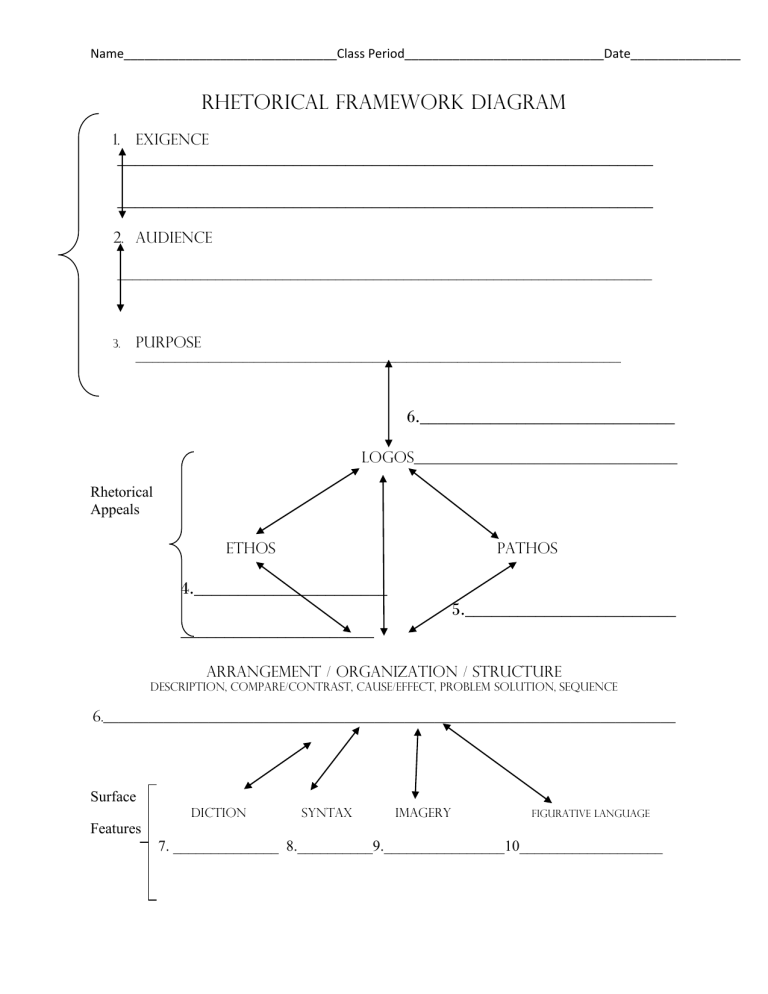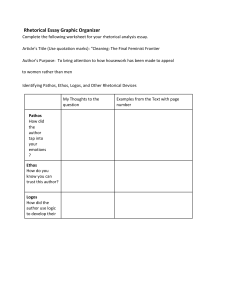
Name_______________________________Class Period_____________________________Date________________ Rhetorical Framework Diagram 1. Exigence _____________________________________________________________ _____________________________________________________________ 2. Audience _______________________________________________________________________ 3. Purpose ______________________________________________________________________________________ 6._____________________________ Logos___________________________________ Rhetorical Appeals Ethos Pathos 4.______________________ 5.________________________ ______________________ Arrangement / Organization / Structure Description, compare/contrast, cause/effect, problem solution, sequence 6.____________________________________________________________________________ Surface Diction Syntax Imagery Figurative Language Features 7. ______________ 8.__________9.________________10___________________ Name_______________________________Class Period_____________________________Date________________ The Rhetorical Situation 1. Exigence: the real world problem, lack, or need that motivates an author to write 2. Target Audience: who is the intended audience 3. Purpose: to persuade, to inform or to entertain Rhetorical Appeals 4. Ethos: appeal to the author credibility (how the author establishes his or her “authority” in the text) Ethos is related to the word ethics and refers to the trustworthiness of the author. Ethos is an effective persuasive strategy because when we believe that the writes does not intend to do us harm, we are more willing to listen to what he or she has to say. For example, when a trusted doctor gives you advice, you may not understand all the medical reasoning behind the advice, but you nonetheless follow the directions because you believe that the doctor knows what he or she is talking about. 5. Pathos: appeal to the emotions (how the authors tugs on our “heartstrings”) Pathos is related to the words sympathy and empathy. It is in operation whenever you accept a claim based on how it makes you feel without fully analyzing the rationale behind the claim. Pathos may be an appeal to any emotion, such as love, fear, patriotism, guilt, hate, and joy. Although the pathetic appeal can be manipulative, it is key to moving people to take action. Many arguments are able to persuade people logically, but the apathetic audience may not follow through on a call to action. 6. Logos: appeal to logic, including both Paradigms: inductive reasoning through patterns of examples (a series of at least three examples is need to properly support a logical claim) Enthymemes: deductive reasoning through rhetorical syllogisms [logical deductions consisting of (1) major premises, (2) minor premises, and (3) conclusions] The Greek word logos is the basis for the English word logic. Logos is a broader idea than formal logic—the highly symbolic and mathematical logic studied in a philosophy course. Logos refers to any attempt to appeal to the intellect, the general meaning of “logical argument.” Everyday arguments rely heavily on ethos and pathos, but academic arguments rely more on logos.


